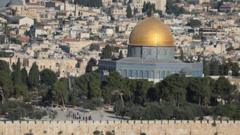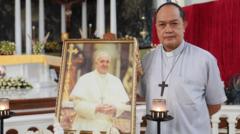BOSTON (Deep Roots News) — As peak holiday travel begins, the search for a peaceful moment within the bustling terminals can often feel like a distant wish. Yet, airport chapels have been a source of solace for travelers and airport employees alike for decades.
“Seeing travelers pause amidst their journeys and the attire of those working around offers a sense of hope,” shares Rev. Brian Daley, a priest at Our Lady of the Airways chapel located at Logan International Airport in Boston.
Founded in the 1950s primarily to serve the local workforce, this chapel holds the distinction of being one of the first dedicated airport chapels in the United States. Unlike many contemporary chapels, it preserves its identity as a Catholic space, although it discreetly accommodates various faiths, including the presence of Muslim prayer rugs.
On a typical weekday, travelers and employees alike enter the chapel; a man in a reflective vest pauses for prayer, followed by airline staff seeking a moment of respite. For those like Brian Babcock, a baggage handler, the chapel symbolizes a connection to their faith within their workplace. “It's incredible to have a place to step away and pray right where you work,” he remarks.
The Foundation of Airport Chapels
The roots of airport chapels like Our Lady of the Airways stem from a desire to serve working-class individuals who often have demanding schedules. Influenced by social teachings of Pope Leo XIII, church leaders expanded access to spiritual care in busy workplaces, including airports.
This chapel, along with others established at major U.S. airports, ensures that airport workers, especially those on grueling shifts, have convenient access to Mass, reflecting the profound bond between faith and labor.
John Cappucci, a lifelong attendee, states, “It’s serene and offers a retreat from the hustle of the airport,” highlighting the continued relevance of these spaces.
Transition to Interfaith Spaces
While some airport chapels maintain their religious identity, many have embraced interfaith orientations, providing inclusive environments for personal prayer and reflection. This transformation reflects a broader trend where religious symbols are replaced with neutral settings to welcome all believers and non-believers alike.
Wendy Cadge, a sociology professor, notes that the facilities found at airports often adapt to local demographics and the faith needs of an increasingly diverse traveler population. “Most recent chapels have taken on a less defined religious character,” she explains.
Preserving Spiritual Heritage
At airports like Chicago’s O’Hare, spiritual leaders strive to maintain the essence of their dedicated chapels amidst a growing emphasis on interfaith spaces. The interfaith chapel, which features views of taxiing aircraft, serves as a reminder of the intersection of faith and travel.
In Boston, employees at Our Lady of the Airways express hope for its continued existence as a refuge in the midst of travel’s chaos. “We come here to pray and find peace before our shifts,” say two JetBlue workers, emphasizing the ongoing importance of spiritual refuge in their daily routines.
As the holiday travel season unfolds, these chapels remain vital sanctuaries for those navigating the stresses of travel and work, demonstrating the enduring power of faith in busy public spheres.






















